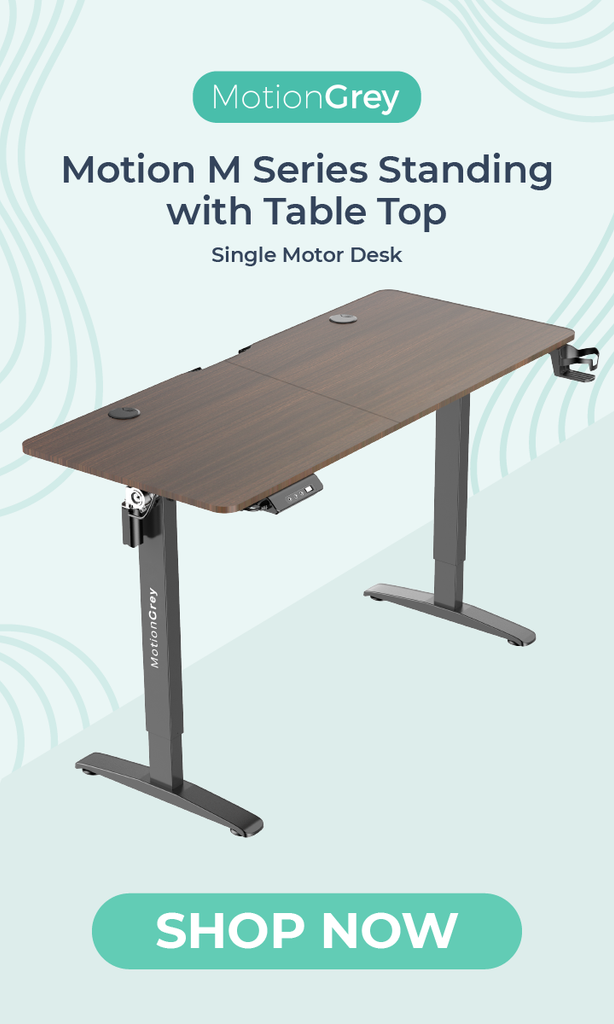Can Standing Fix Turtle Neck Syndrome?

In an era where digital screens reign supreme and sedentary habits have become the norm, the accompanying health issues associated with modern living are on the rise.
Among the myriad concerns, a conspicuous challenge has emerged—the "Turtle Neck Syndrome." Coined to depict the forward head posture and neck strain resulting from the extended use of smartphones, computers, and digital devices, this syndrome has propelled us into a quest for solutions.
A pivotal question looms large: Can incorporating more standing into our routines be the key to fixing Turtle Neck Syndrome?
Understanding Turtle Neck Syndrome
Turtle Neck Syndrome, alternatively known as Forward Head Posture or Text Neck, is characterized by the forward positioning of the head and neck. This posture places excessive strain on the cervical spine, with the relatively heavy human head leaning forward, thereby intensifying pressure on the neck and upper spine. The consequences can manifest in various issues, ranging from persistent neck and shoulder pain to debilitating headaches and potential long-term spinal problems.
Effects of Turtle Neck Syndrome
Muscle Strain and Tension
Prolonged forward head posture can lead to strain on the muscles of the neck and shoulders. This can result in discomfort, stiffness, and pain.
Headaches
Poor neck posture can contribute to tension headaches due to increased stress on the neck muscles and surrounding structures.
Reduced Range of Motion
Habitual poor neck posture may lead to a decrease in the range of motion in the neck, making it difficult to turn or tilt the head comfortably.
Cervical Disc Compression
Forward head posture can also increase the pressure on the cervical discs in the neck. Over time, this may contribute to disc degeneration and potential herniation.
Nerve Compression
Poor neck posture can compress nerves in the cervical region, leading to numbness, tingling, or weakness in the arms and hands.
Jaw Issues
Misalignment of the neck can also contribute to temporomandibular joint (TMJ) issues, leading to jaw pain and dysfunction.

Lifestyle Change as a Remedy for Turtle Neck Syndrome
Recognizing Turtleneck Syndrome as predominantly a lifestyle problem underscores the urgency to modify our habits for effective correction. This entails addressing the root causes, which usually include prolonged periods of screen time, poor posture, and insufficient physical activity.
The Role of Standing in Fixing Turtle Neck Syndrome
Recent years have seen heightened awareness regarding the health risks associated with prolonged sitting, linking sedentary behavior to a spectrum of health concerns such as obesity, cardiovascular issues, and musculoskeletal problems. In response, standing desks have gained popularity as a countermeasure to fix turtle neck. Can standing more be a remedy for Turtle Neck Syndrome? The answer lies in the multifaceted benefits of adopting a standing-oriented lifestyle.
Regular standing promotes a more neutral spine alignment, alleviating strain on the neck and upper back. It serves as a proactive measure against the forward head position characteristic of Turtle Neck Syndrome, actively contributing to improved posture.
Incorporating Movement into Daily Life to Prevent Severe Turtleneck Syndrome
While standing desks mark a positive stride in addressing Turtle Neck, the crux lies in infusing movement throughout the day. Regular breaks dedicated to stretching, walking, and engaging in targeted neck and shoulder exercises play a crucial role in correcting and preventing severe Turtleneck Syndrome.
Ergonomics and Posture Awareness to Prevent Severe Turtleneck Syndrome
Promoting ergonomics in your space and lifestyle extends beyond standing. Ensuring that screens are at eye level, employing supportive chairs, and cultivating proper posture awareness are indispensable components in tackling the root causes of Turtle Neck Syndrome.

Standing as a Remedy for Severe Turtleneck Syndrome
Advocates of standing as a remedy for severe Turtleneck Syndrome contend that embracing a standing desk or incorporating more standing into daily activities can help counteract the negative effects of prolonged sitting. The rising popularity of standing desks stems from their potential to promote better posture, reduce sedentary behavior, and alleviate musculoskeletal issues associated with extended periods of sitting.
How Standing Helps Fix Turtle Neck Syndrome
Neutral Spine Alignment
Standing naturally encourages a more neutral spine alignment, effectively reducing the strain on the neck and upper back. The force of gravity is distributed more evenly, minimizing the forward head posture that characterizes Turtleneck Syndrome.
Engagement of Core Muscles
When standing, the body engages core muscles to maintain balance and stability. This engagement actively supports the spine, decreasing the likelihood of slouching or adopting poor postures that contribute to Turtle Neck Syndrome.
Increased Blood Circulation
Standing promotes better blood circulation throughout the body, ensuring that muscles and tissues receive a supply of oxygen and nutrients. Improved circulation contributes to the prevention of stiffness and discomfort.
Encourages Movement
Standing desks often feature adjustable height settings, enabling individuals to seamlessly transition between sitting and standing throughout the day. This promotes regular movement, preventing the prolonged static postures that contribute to severe Turtleneck Syndrome.
How to Fix Turtle Neck: Considerations and Limitations
While standing desks offer potential benefits, it's crucial to approach them with a balanced perspective, especially when dealing with severe Turtleneck Syndrome. Standing for extended periods without proper ergonomics or breaks can lead to its own set of issues, including fatigue and discomfort. Finding a balanced harmony between sitting, standing, and movement throughout the day is essential for overall well-being.
Moreover, standing alone may not serve as a comprehensive solution for Turtle Neck Syndrome. Combining standing with other ergonomic adjustments, incorporating stretching exercises, and embracing lifestyle modifications is likely to yield more effective results in preventing and addressing this condition.

How to Fix Turtle Neck: Actions to Take
As you navigate the challenges posed by Turtle Neck Syndrome in this digital age, consider taking proactive steps to fix turtle neck condition and enhance your musculoskeletal well-being. Here's your call to action:
Evaluate Your Workstation
Assess your work environment, ensuring that your screens are at eye level, chairs are supportive, and your overall setup promotes good posture. Small adjustments in fixing turtleneck syndrome can make a significant difference.
Incorporate Standing Breaks
If possible, integrate standing breaks into your daily routine. Whether using a standing desk or simply taking short breaks to stretch and move, these can contribute to improved posture and reduced strain.
Prioritize Movement
Embrace the power of movement. Dedicate time to stretching, walking, and engaging in targeted neck and shoulder exercises. This can counteract the effects of prolonged sitting and promote a healthier, more active lifestyle.
Take a Holistic Approach
Understand that standing is just one piece of the puzzle on how to fix turtle neck, combine it with other ergonomic adjustments, stretching exercises, and overall lifestyle modifications for a holistic strategy in preventing and addressing Turtleneck Syndrome.
Consult with Professionals
If you experience persistent discomfort or pain, seek guidance from healthcare professionals. They can provide personalized advice, identify specific issues, and recommend tailored treatments for your unique situation.
By taking these steps, you're not only working towards fixing Turtle Neck Syndrome but also fostering a comprehensive approach to enhance your overall well-being. Remember, your musculoskeletal health is a valuable asset, and investing in it today can lead to a healthier and more comfortable tomorrow.
About Us
MotionGrey is a Canadian standing desk company that specializes in ergonomic furniture. We supply and install only the best quality standing desks and ergonomic chairs in the country. We offer free shipping within Canada and the US.
What made you switch to standing desks? Our products are designed with wellness as the focal point. From our electric standing desks to our office and gaming chairs, we deliver best value by putting your health, safety, and comfort as top priority. Boost your creativity and level up work performance. We want you to create great outcomes so we’re providing you only the best tools to make them possible.
If you are not satisfied with your purchase, check out our Refund Policy.





